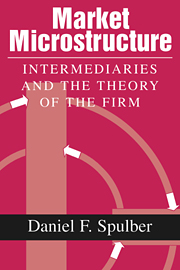Book contents
- Frontmatter
- Contents
- Preface and acknowledgments
- Introduction
- Part I Market microstructure and the intermediation theory of the firm
- Part II Competition and market equilibrium
- Part III Intermediation versus decentralized trade
- Part IV Intermediation under asymmetric information
- Part V Intermediation and transaction-cost theory
- 9 Transaction costs and the contractual theory of the firm
- 10 Transaction costs and the intermediation theory of the firm
- Part VI Intermediation and agency theory
- Conclusion
- References
- Index
10 - Transaction costs and the intermediation theory of the firm
Published online by Cambridge University Press: 18 December 2009
- Frontmatter
- Contents
- Preface and acknowledgments
- Introduction
- Part I Market microstructure and the intermediation theory of the firm
- Part II Competition and market equilibrium
- Part III Intermediation versus decentralized trade
- Part IV Intermediation under asymmetric information
- Part V Intermediation and transaction-cost theory
- 9 Transaction costs and the contractual theory of the firm
- 10 Transaction costs and the intermediation theory of the firm
- Part VI Intermediation and agency theory
- Conclusion
- References
- Index
Summary
The analysis of intermediation and market microstructure in the preceding chapters lays the groundwork for a theory of the firm. That theory is distinct from the neoclassical, industrial-organization, and contractual theories discussed so far. The intermediation theory of the firm explains both why firms exist and what economic functions the firm carries out. The theory of the firm is based on a comparison between intermediated exchange and direct exchange. Economic agents create firms to intermediate transactions between buyers and sellers when net gains from trade exceed those obtained through direct exchange. The boundaries of the firm are determined by the set of complementary transactions that the firm assembles. Firms are formed to carry out innovative transactions, finding those that yield the greatest value added net of transaction costs.
The intermediation theory of the firm also provides an explanation of how markets work and what institutions of exchange will prevail in competition. Intermediaries create and manage the institutions of exchange through their pricing and market-making activities. The most efficient market microstructure produces the greatest gains from trade net of transaction costs. Competition between intermediaries seeking to serve the market should enhance the efficiency of market microstructure.
Intermediation theory is concerned with both the benefits and costs of transactions. In this sense the intermediation theory differs from the contractual theory of the firm, which concentrates on transaction-cost avoidance. By including the benefits of transactions in the analysis, the intermediation theory shows that firms are concerned with capturing gains from trade, the difference between consumer willingness to pay and supplier opportunity cost.
- Type
- Chapter
- Information
- Market MicrostructureIntermediaries and the Theory of the Firm, pp. 256 - 286Publisher: Cambridge University PressPrint publication year: 1999



